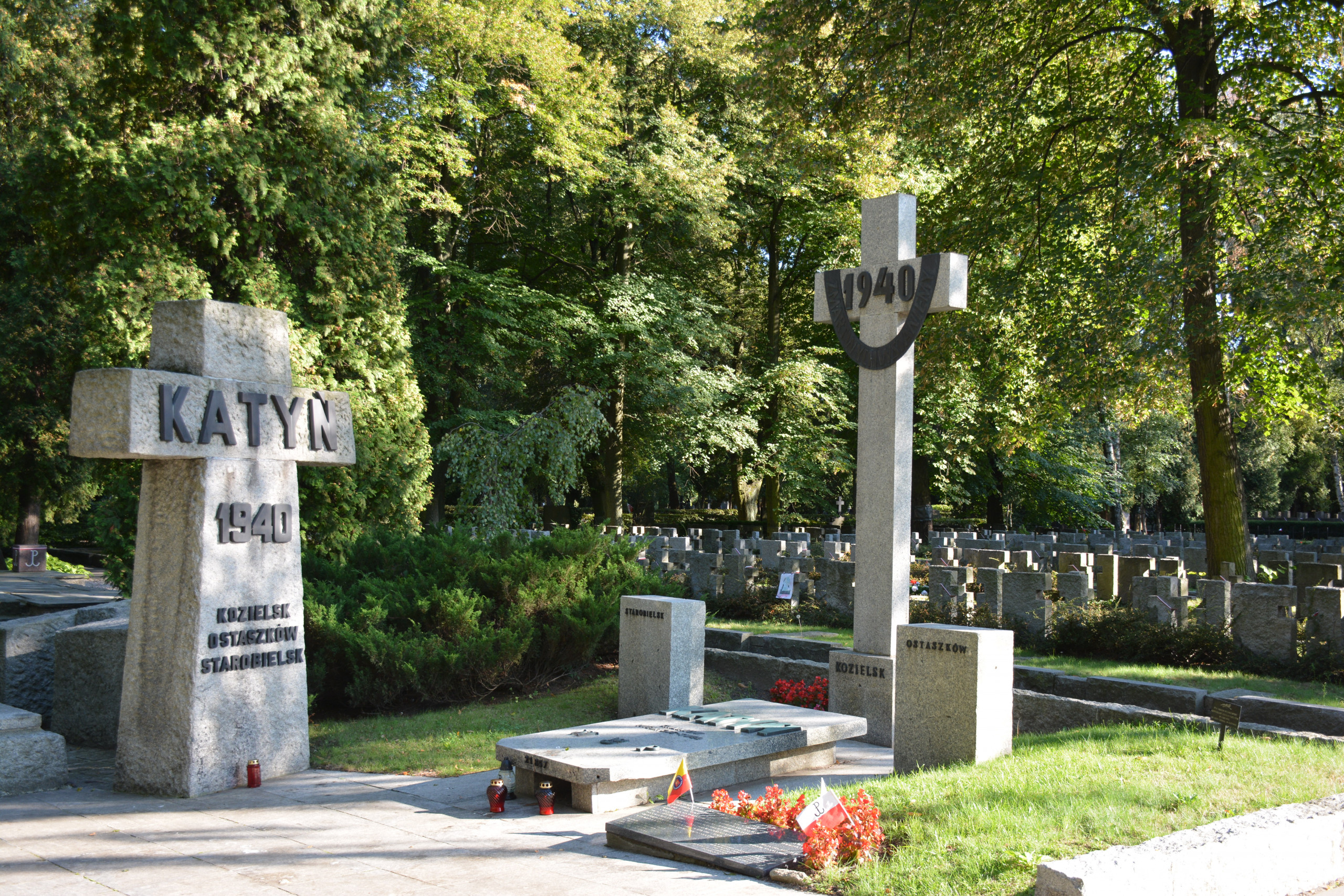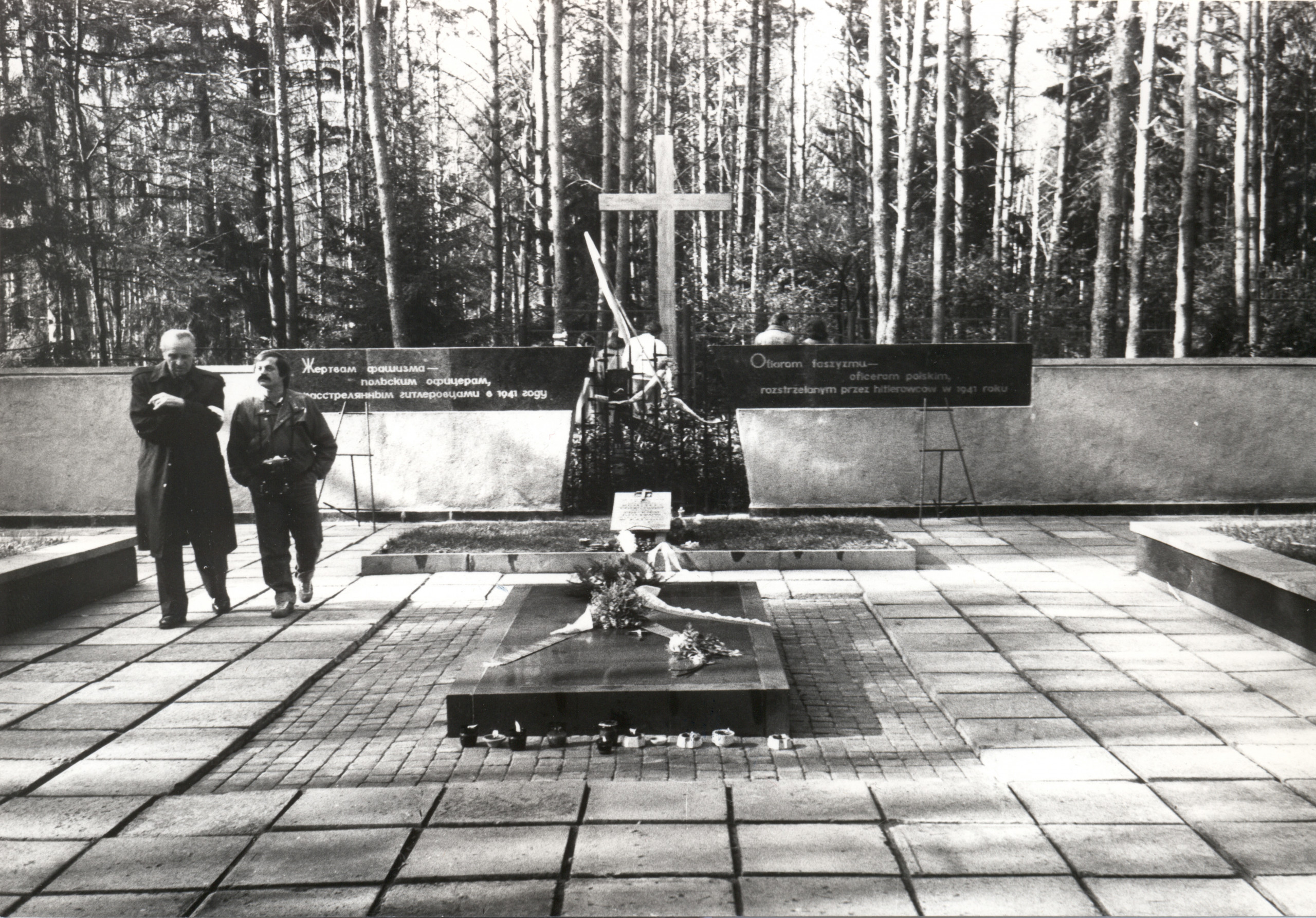This website uses different cookies. We use cookies to personalise content, provide social media features, and analyse traffic to our website. Some cookies are placed by third parties that appear on our pages. You can find more information and options to choose from in our Privacy Policy and Configurations for usage.
The Katyń massacre: human rights and the Katyń lie
Anna Skiendziel Complex of Technical and Secondary Schools No. 2, Katowice, Poland
15-20 years
90 mins, or 2 x 45 mins
Key question: How can the history of the Katyń massacre be used to illustrate the way monuments are used to try and hide war crimes?
1 The Katyń lie came to be known about after 11 April 1943, when the Germans revealed that they had found the mass graves of Polish officers murdered by the Soviets. The USSR firmly denied responsibility and blamed the Third Reich. See Przewoźnik, A. & Adamska, J. (2011). Zbrodnia katyńska. Mord, kłamstwo, pamięć [The Katyń Crime. Murder, Lies, Memory], Kraków: Wydawnictwo Literackie.
Learning outcomes
Students will:- Understand the value of human rights and the importance of respect for human dignity through the history of the Katyń massacre.
- Develop critical skills in approaching historical information and sources.
- Understand that there may be different perspectives on the same events in history.
- Understand that past events can be useful to understand the present and help to build the future.
- Develop analytical thinking skills.
Pedagogical Recommendations
The lesson should be carried out after World War II has already been taught and discussed in the classroom. Students should have a basic understanding of what happened during and after World War II as well as basic notions of international law and human rights.The Katyń Monument encourages discussion of human rights, values, disinformation, and historical lies. There is no need to visit the site directly for students to understand the topic better.
Activities
Stage 1: Introduction. 5 minutesThe teacher briefly explains the aims of the lesson and why the Katyń issue is an important one.
Stage 2: Photo comparison & discussion. 25 minutes
The lesson begins by showing two photographs of the Katyń Monument. One photo comes from The Powązki Cemetery, Warsaw (Poland, 2016), the other from Katyń (Soviet Union, 1988).


- What do you see in the photos?
- Are there any differences between the monuments in the photos?
- What event do the monuments commemorate?
- Why do you think the date was changed to 1941 in one of the photos?
- Does it matter that someone wanted to change the date of the Katyń massacre? Who would care about it and why?
Stage 3: Lecture about the history of the Katyń lie. 15 minutes
The teacher should explain the history of the lie, making sure to include the following points.
- The discovery of mass graves in the Katyń and elsewhere by the Germans in 1941 (after their attack on the USSR)
- The denial by the USSR and the USSR’s blaming of the Germans
- The research of Nikolai Burdenko’s Soviet commissions
- The exclusion of the Katyń massacre from the Nuremberg trial
- Censorship in the press and in schools during the communist period
- The act of self-immolation of the former Home Army soldier Walenty Badylak in Kraków in 1980 against hiding the truth about Katyń
At this point, the first 45 minutes should be up. It is a suitable point to end the first lesson if the learning activities are to be split into two lessons. If not, it is a good time for a break.
Stage 4: Recap. 10 minutes
The next part of the lesson (or the second lesson, if the material is divided into two) begins with the teacher showing again the photo of the monument built in Katyń.
The teacher asks: Why would the Soviet Union want to erect this type of monument with such an inscription as late as 1988? The question will also help recall the content of the previous lesson. It also introduces to the students the Polish perspective and Polish efforts to find the truth about the Katyń massacre.
Stage 5: History of the monument. 10 minutes
After recalling the content of the first half of the lesson (the previous lesson if the material is divided), teachers display or give students a text about the history of the monument in Powązki (see Appendix II). After reading in pairs, the students make notes on the difficulties in commemorating the Katyń massacre.
Stage 6: Discussion. 10 minutes
Next, the teacher returns to the photo of the monument in Powązki and the fifth question: Does it matter that someone wanted to change the date of the Katyń massacre? Who would care about it and why? Students are now asked to compare their current answers with those from the beginning of the lesson (or from the first lesson if the material is divided). The teacher and the students discuss human rights and values during and after the war.
Stage 7: Reflection. 15 minutes
At the end of the lesson, there is a short reflection/discussion. The following questions can be used to lead and support the discussion:
- Why are we discussing this topic?
- What conclusions can we draw when discussing the Katyń massacre?
- Why is a critical approach to assessing sources and information important?
Assessment
Below are several points that can be used as a suggestion of how the teacher may assess the learning activity during the lesson:- At what level does the student use observation and analytical skills? How much can they distinguish between important/primary and unimportant/secondary information?
- How much does the student contribute?
- How skilled are the students in cooperating and working together as a group?
Glossary
Here you can find definitions for the words in bold below.- Federation of Katyń Families – a Polish non-governmental organisation that brings together activists from all over the country, with the goal of commemorating the victims of the Katyń massacre and cherishing the memory of Polish victims of communism in the USSR.
- The Home Army (Polish: Armia Krajowa, or AK) – the biggest resistance movement in German-occupied Poland during World War II. The Home Army was formed in February 1942 from the earlier Związek Walki Zbrojnej (Armed Resistance).
- Martial law – the state of emergency introduced on 13 December 1981 throughout the Polish People's Republic, contrary to the Constitution of the Polish People's Republic. It was suspended on 31 December 1982 and lifted on 22 July 1983.
- NKVD (Russian: Наро́дный комиссариа́т вну́тренних дел) – the People’s Commissariat for Internal Affairs. Established in 1917, the agency was initially tasked with conducting regular police work and overseeing the country's prisons and labour camps in the USSR. It was responsible for the mass extrajudicial executions of citizens and conceived the GULAG network of camps.
- The Security Service – an institution established to protect state security and public order in the People's Republic of Poland.
- Stefan Niedzielak (1914-1989) – a Roman Catholic priest, chaplain of the Home Army and WiN, co-founder of the Katyń Families.
- WiN or Zrzeszenie Wolność i Niezawisłość (English: Freedom and Independence Association) – a Polish underground anticommunist organisation founded on 2 September 1945 and active until 1952.
- Władysław Badylak (1904-1980) – a soldier of the Home Army, a retired Krakow baker who chained himself to a historic well in the Krakow market square, poured gasoline over himself and set himself on fire. His act was a protest against the silence of the authorities about the Katyń massacre.
Appendix I – Map of the massacre of Katyń

Appendix II – The history of the monument’s construction in Powązki
Since the 1950s, attempts have been made to commemorate the victims of the Katyń massacre in the places where monuments now stand. Each attempt ended with a reaction of the communist authorities and the Security Service.In the Katyń Valley in modern day Russia there are two monuments in the form of crosses, officially unveiled on 31 July 1995. These are 1) the so-called ‘social monument’, which was placed in the Katyń Valley twice (first in 1981 and then in 1995), and 2) the so-called ‘government monument’, erected in 1985, originally with a different inscription.
In May 1981, the illegal Civic Committee for the Construction of the Katyń Monument was established in Warsaw. On 31 July 1981, members of the Committee set up a 4.5-metre-high stone cross in the Katyń Valley with the date 1940, a crowned eagle, a plaque with the inscriptions Katyń and Wojsko Polskie (Polish Army), and posts with the names of the NKVD camps where Polish prisoners of war were held in captivity after the USSR’s aggression against Poland in 1939. The initiators of the cross were the priest Stefan Niedzielak and Stefan Melak. The same night, the cross was disassembled and removed by the Security Service using a large crane. Two more attempts to erect a cross were made, but each time the crosses were removed. At the turn of April and March 1985, without prior announcement and without an unveiling ceremony, the authorities of the Polish People's Republic erected a white granite cross, 4 metres high, with a false inscription: “Polish soldiers, victims of Nazi fascism resting in the Katyń region – 1941.” The text of the inscription caused indignation among Poles and the topic was covered in newspapers as far away as Switzerland. This also caused outrage in Germany and was discussed at a Bundestag meeting. Chancellor Helmut Kohl stated that the Polish side had been informed that the German government did not understand this falsification of history and that it felt offended by this fact.
In 1989, one of the initiators of the monument and the guardian of the Katyń families, the priest Stefan Niedzielak, was murdered. At the end of March 1989, the false inscription was removed, but no new information was provided about the true date and persons responsible for the Katyń massacre. The situation changed only after the collapse of the communist government in Poland and then the USSR.
Sources: Przewoźnik, A. & Adamska, J. (2010). Katyń. Zbrodnia, prawda, pamięć [Katyń. Crime, truth, memory], Świat Książki: Warszawa; Wasilewski, W. (2009). ‘Pamięć Katynia. Działania opozycji’ [The Memory of Katyń. Opposition activities], Biuletyn IPN, 5(6), pp. 60-70.
Appendix III – Recommended reading and further research for teachers
To find out more about the Katyń massacre and subsequent lie, we recommend the following sources:- (PL/EN) ‘KATYŃ – Historia wciąż żywa’ [Katyń - History Still Alive], YouTube IPNtvPL, accessed 24 January 2023.
- (PL/EN) ‘Historia zbrodni’ [History of a crime], Narodnowe Centrum Kultury – Remembrance campaign and detailed history of events, accessed 24 January 2023.
- (EN) ‘The Katyń Massacre – Basic Facts’, Institute of National Remembrance, accessed 24 January 2023.
- (EN) ‘The Katyń lie. Its rise and duration’, Institute of National Remembrance, accessed 24 January 2023.
- (PL/EN) ‘Katyń - the true story of a lie’, YouTube Muzeum Historii Polski w Warszawie, accessed 24 January 2023.
Download guide
Other Lesson Materials
The beginning and end of World War II
Children in World War II
Remembrance and memorialisation of World War II in different countries
Young people and forced labour during World War II
Border changes resulting from World War II
Consequences of World War II